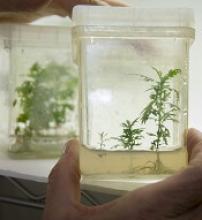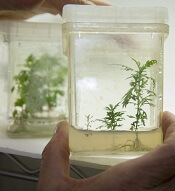User login
Researchers have reported that tablets made from dried leaves of the Artemisia annua plant were able to cure malaria in 18 critically ill patients in a clinic in Africa.
When standard malaria medications failed to help the patients, the attending physician at the clinic acted under the compassionate use doctrine and prescribed the unapproved therapy, known as dried-leaf Artemisia (DLA).
Within 5 days, all 18 patients had fully recovered, with lab tests showing no parasites in their blood.
Details on this small trial were published in Phytomedicine.
The trial included 18 patients in the North Kivu province of the Democratic Republic of Congo who showed symptoms of malaria and were originally treated with artemisinin-based combination therapy (ACT).
The patients, who ranged in age from 14 months to 60 years, did not respond to ACT and lapsed into severe malaria.
Seven of the patients had anemia, 6 had convulsions, and 4 had vomiting and diarrhea. One patient, a 5-year-old child, became comatose.
All of the patients were then treated with intravenous artesunate, but they showed no improvement.
As a last resort, doctors turned to DLA. After 5 days of treatment with DLA tablets, all 18 patients fully recovered. Tests showed they had no parasites remaining in their blood.
The researchers said the DLA tablets were well-tolerated, as there were no side effects observed.
“These 18 patients were dying,” said study author Pamela Weathers, PhD, of Worcester Polytechnic Institute in Massachusetts.
“So to see 100% recover, even the child who had lapsed into a coma, was just amazing. It’s a small study, but the results are powerful.”
Dr Weathers noted that more than 100 other drug-resistant patients have been successfully treated with DLA tablets.
She said the superior performance of DLA in comparison to ACT, as well as DLA’s ability to kill drug-resistant parasites and avoid the resistance trap itself, is likely due to the synergistic effects of a complex array of phytochemicals contained in the plant’s leaves.
Several of these phytochemicals are known to have antimalarial properties, and others may act both to enhance the absorption of artemisinin into the bloodstream and bolster its effectiveness against malaria.
In effect, the dried leaves constitute a robust natural combination therapy, one whose benefits surpass those of ACT and other combination drugs.
“We have done a lot of work to understand the biochemistry of these compounds, which include a number of flavonoids and terpenes, so we can better understand the role they play in the pharmacological activity of the dried leaves,” Dr Weathers said.
“The more we learn, the more excited we become about the potential for DLA to be the medication of choice for combating malaria worldwide. Artemisia annua is known to be efficacious against a range of other diseases, including other tropical maladies and certain cancers. So, in our lab, we are already at work investigating the effectiveness of DLA with other diseases.”
Another advantage of DLA over conventional malaria treatments is its low cost and the relative simplicity of its manufacture, Dr Weathers said. When compared to ACT, producing DLA tablets can be accomplished with simpler equipment and a modest amount of training.
Growing Artemisia annua and producing and testing the tablets, Dr Weathers noted, are ideal local business ventures that can provide jobs in impoverished areas and greatly expand access to antimalarial therapy.
In fact, she has already established a supply chain in Africa that includes growing and harvesting high-producing cultivars in East Africa, along with Good Manufacturing Practice processing operations in Uganda where the leaves are dried, pulverized, and homogenized; the powder is compacted into tablets; and the tablets are tested to verify their dosage.
This supply chain helped produce the tablets used to treat the 18 patients in the Democratic Republic of Congo. ![]()
Researchers have reported that tablets made from dried leaves of the Artemisia annua plant were able to cure malaria in 18 critically ill patients in a clinic in Africa.
When standard malaria medications failed to help the patients, the attending physician at the clinic acted under the compassionate use doctrine and prescribed the unapproved therapy, known as dried-leaf Artemisia (DLA).
Within 5 days, all 18 patients had fully recovered, with lab tests showing no parasites in their blood.
Details on this small trial were published in Phytomedicine.
The trial included 18 patients in the North Kivu province of the Democratic Republic of Congo who showed symptoms of malaria and were originally treated with artemisinin-based combination therapy (ACT).
The patients, who ranged in age from 14 months to 60 years, did not respond to ACT and lapsed into severe malaria.
Seven of the patients had anemia, 6 had convulsions, and 4 had vomiting and diarrhea. One patient, a 5-year-old child, became comatose.
All of the patients were then treated with intravenous artesunate, but they showed no improvement.
As a last resort, doctors turned to DLA. After 5 days of treatment with DLA tablets, all 18 patients fully recovered. Tests showed they had no parasites remaining in their blood.
The researchers said the DLA tablets were well-tolerated, as there were no side effects observed.
“These 18 patients were dying,” said study author Pamela Weathers, PhD, of Worcester Polytechnic Institute in Massachusetts.
“So to see 100% recover, even the child who had lapsed into a coma, was just amazing. It’s a small study, but the results are powerful.”
Dr Weathers noted that more than 100 other drug-resistant patients have been successfully treated with DLA tablets.
She said the superior performance of DLA in comparison to ACT, as well as DLA’s ability to kill drug-resistant parasites and avoid the resistance trap itself, is likely due to the synergistic effects of a complex array of phytochemicals contained in the plant’s leaves.
Several of these phytochemicals are known to have antimalarial properties, and others may act both to enhance the absorption of artemisinin into the bloodstream and bolster its effectiveness against malaria.
In effect, the dried leaves constitute a robust natural combination therapy, one whose benefits surpass those of ACT and other combination drugs.
“We have done a lot of work to understand the biochemistry of these compounds, which include a number of flavonoids and terpenes, so we can better understand the role they play in the pharmacological activity of the dried leaves,” Dr Weathers said.
“The more we learn, the more excited we become about the potential for DLA to be the medication of choice for combating malaria worldwide. Artemisia annua is known to be efficacious against a range of other diseases, including other tropical maladies and certain cancers. So, in our lab, we are already at work investigating the effectiveness of DLA with other diseases.”
Another advantage of DLA over conventional malaria treatments is its low cost and the relative simplicity of its manufacture, Dr Weathers said. When compared to ACT, producing DLA tablets can be accomplished with simpler equipment and a modest amount of training.
Growing Artemisia annua and producing and testing the tablets, Dr Weathers noted, are ideal local business ventures that can provide jobs in impoverished areas and greatly expand access to antimalarial therapy.
In fact, she has already established a supply chain in Africa that includes growing and harvesting high-producing cultivars in East Africa, along with Good Manufacturing Practice processing operations in Uganda where the leaves are dried, pulverized, and homogenized; the powder is compacted into tablets; and the tablets are tested to verify their dosage.
This supply chain helped produce the tablets used to treat the 18 patients in the Democratic Republic of Congo. ![]()
Researchers have reported that tablets made from dried leaves of the Artemisia annua plant were able to cure malaria in 18 critically ill patients in a clinic in Africa.
When standard malaria medications failed to help the patients, the attending physician at the clinic acted under the compassionate use doctrine and prescribed the unapproved therapy, known as dried-leaf Artemisia (DLA).
Within 5 days, all 18 patients had fully recovered, with lab tests showing no parasites in their blood.
Details on this small trial were published in Phytomedicine.
The trial included 18 patients in the North Kivu province of the Democratic Republic of Congo who showed symptoms of malaria and were originally treated with artemisinin-based combination therapy (ACT).
The patients, who ranged in age from 14 months to 60 years, did not respond to ACT and lapsed into severe malaria.
Seven of the patients had anemia, 6 had convulsions, and 4 had vomiting and diarrhea. One patient, a 5-year-old child, became comatose.
All of the patients were then treated with intravenous artesunate, but they showed no improvement.
As a last resort, doctors turned to DLA. After 5 days of treatment with DLA tablets, all 18 patients fully recovered. Tests showed they had no parasites remaining in their blood.
The researchers said the DLA tablets were well-tolerated, as there were no side effects observed.
“These 18 patients were dying,” said study author Pamela Weathers, PhD, of Worcester Polytechnic Institute in Massachusetts.
“So to see 100% recover, even the child who had lapsed into a coma, was just amazing. It’s a small study, but the results are powerful.”
Dr Weathers noted that more than 100 other drug-resistant patients have been successfully treated with DLA tablets.
She said the superior performance of DLA in comparison to ACT, as well as DLA’s ability to kill drug-resistant parasites and avoid the resistance trap itself, is likely due to the synergistic effects of a complex array of phytochemicals contained in the plant’s leaves.
Several of these phytochemicals are known to have antimalarial properties, and others may act both to enhance the absorption of artemisinin into the bloodstream and bolster its effectiveness against malaria.
In effect, the dried leaves constitute a robust natural combination therapy, one whose benefits surpass those of ACT and other combination drugs.
“We have done a lot of work to understand the biochemistry of these compounds, which include a number of flavonoids and terpenes, so we can better understand the role they play in the pharmacological activity of the dried leaves,” Dr Weathers said.
“The more we learn, the more excited we become about the potential for DLA to be the medication of choice for combating malaria worldwide. Artemisia annua is known to be efficacious against a range of other diseases, including other tropical maladies and certain cancers. So, in our lab, we are already at work investigating the effectiveness of DLA with other diseases.”
Another advantage of DLA over conventional malaria treatments is its low cost and the relative simplicity of its manufacture, Dr Weathers said. When compared to ACT, producing DLA tablets can be accomplished with simpler equipment and a modest amount of training.
Growing Artemisia annua and producing and testing the tablets, Dr Weathers noted, are ideal local business ventures that can provide jobs in impoverished areas and greatly expand access to antimalarial therapy.
In fact, she has already established a supply chain in Africa that includes growing and harvesting high-producing cultivars in East Africa, along with Good Manufacturing Practice processing operations in Uganda where the leaves are dried, pulverized, and homogenized; the powder is compacted into tablets; and the tablets are tested to verify their dosage.
This supply chain helped produce the tablets used to treat the 18 patients in the Democratic Republic of Congo. ![]()

